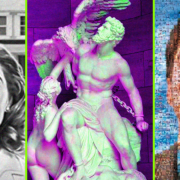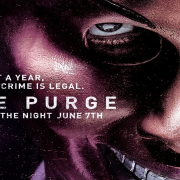Creative Bankruptcy Leads to Political Idolatry
On the surface, Mel Gibson and David Lynch have very little in common other than the fact that both are exceptionally good storytellers. However, it is time we focus on what makes these two great and relevant at the ground zero of our creatively bankrupt culture.
In 2005 Mel Gibson directed and released what many consider to be his magnum opus: The Passion of the Christ, a film based on the last hours of Christ on Earth. It took the world by storm, scoring huge at the box office and leading many to convert to Christianity; a phenomenal feat for any artistic endeavor. Another curious thing it did was to rekindle the genre of Biblical filmmaking which lay dormant for decades before its release.
The Biblical-themed movies that came after Passion, however, lacked depth, and the reason for this is that most of them sought to preach, thus breaking the cardinal rule of storytelling which is “show, not tell.” This Ayn Randian method of storytelling—shoving the message down the viewer’s throat—has plagued not only filmmakers but artists and critics of all stripes in our time. Many forget that one of the biggest reasons why Mel Gibson’s Passion worked is because the story was Gibson’s personal vision. He wrote the following:
“People often ask me why I wanted to make a film about the Passion of Our Lord… The reality, of course, is more complex, and had its genesis during a time in which I found myself trapped with feelings of terrible, isolated emptiness. Because I was brought up to be a good Christian and a good Catholic, the only effective resource for me was prayer. I asked God for His help.”1
Self-proclaimed critics write all sorts of things about historical, theological, or ideological accuracies, but rarely are they willing to dive deep into the mind of a creator. Artists who are in sync with the Creator aren’t mere conveyors of brute facts; they are more interested in the truth that lies beyond what we perceive to be “facts.” Director Werner Herzog would sometimes invent scenes in his documentaries. In Little Dieter Needs to Fly, Herzog invents a scene where Dieter Dengler, once a prisoner of war, repeatedly opens and closes his door to remind himself of his freedom. The reason for this is to convey what Herzog calls “ecstatic truth”—truth that illuminates on a deeper and emotional level. “There is just a very shallow truth in facts,” Herzog says, “Otherwise, the phone directory would be the Book of Books.”2 Perhaps the normative sense of being hyper-consumed by ideas and historicity is what liberals rail against when they speak of “my truth” or “your truth.” Sadly their reaction too would become entrenched in ideology, thus proving the point that a personal vision cannot be communicated through anything other than the human person.
Gibson’s ability to draw from the well of personal isolation can be seen in the opening scenes of Braveheart through the eyes of a young William Wallace as he comes to grips with the passing of his father and brother. A young boy witnessing the departure of his father is something that is both universal and personal. The theme of parental affection is again revisited in Passion where the viewer catches a glimpse into the everyday life of Jesus and his mother. Gibson masterfully juxtaposes Jesus’s cruciform march to Calvary with a flashback scene where Christ displays playful affection towards a mother who feigns annoyance. Scripture hardly mentions any interaction between Christ and His mother, so it is safe to assume that scene was entirely of Gibson’s making. These cinematic moments were designed, I think, not only to evoke tears but also to test the audience’s sanity. As T3Uncoupled writes here: “… sometimes the only response to the overwhelming nature of being is to weep.”
One of the reasons why storytelling has become a lost art among both conservatives and liberals is probably because ideologies do not blend well with the paradoxical. In this age of certainty, we have developed into a speech-heavy culture of spoon-feeding listeners as opposed to guiding the viewer through visual cues and letting them work out their own conclusions. The result of this is a prevailing mindset of learned helplessness. The result is an audience clamoring for instant closures and quick dopamine hits that characterize false ecstasy. The result is an emptying of personal imagination, a return to politically-charged scapegoating, and catharsis that gets weaker with every passing day.
David Lynch, who recently passed away, was notorious for keeping his lips tightly sealed on the correct interpretations of his many surrealistic films. What happened in Mulholland Drive? Why is there an ear in the field in Blue Velvet? Who killed Laura Palmer in Twin Peaks? When asked these questions, Lynch would emphatically say, “I won’t tell you.” The reason for this is Lynch’s aversion to closure. In his own words:
“Closure. I keep hearing that word. It’s the theater of the absurd. Everybody knows that on television they’ll see the end of the story in the last 15 minutes of the thing. It’s like a drug. To me, that’s the beauty of “Twin Peaks.” We throw in some curve balls. As soon as a show has a sense of closure, it gives you an excuse to forget you’ve seen the damn thing.”3
In ancient times, storytelling was heavily institutionalized in the form of religious or tribal myths. The purpose of stories back then was to not only provide a sense of purpose but also to hold together societies and keep them from crumbling. Most often these stories would serve as cover-ups for sacrificial murders so that societies are unable to collectively denounce them. Today, societies instinctively cast suspicion on mythologies, sensing that somewhere in our dreamy tales there is a dark secret, thus the clamoring for closure. Lynch, having the mind of a true anthropologist, presents us with the slain corpse at the very outset of Twin Peaks, but denies the revelation of the murderer. It was only after constant studio pressure that Lynch was forced to reveal a murderer to satisfy TV audiences. He would end the show very soon after that.
Lynch’s original intent for Twin Peaks was twofold. First, the show would present the slain victim in the pilot episode, thus dispelling the notion that everything in this obscure town was rosy. Second, Lynch would deny the face of the murderer and force the characters of the show and the viewers to reflect on whether they had something to do with Laura Palmer’s descent into madness; this is, regardless of Lynch’s religious beliefs, profoundly Christian. The tragedy of creativity, which is the end of the process of creating or “closure,” is therefore averted.
The brilliance of open-ended storytelling (and creativity in general) is that it becomes generational and then cosmological. The arc of William Wallace in Braveheart is born from orphanhood but ultimately leads to the freedom of an entire nation. Christ in Passion takes this to an entirely new level where He brings redemption through suffering at the hands of a violent mob. Lynch emphasizes open-endedness, the notion that the future is ours to make, and elevates personal interaction and participation with creation. Take all of this away and you are left with collective violent shortcuts through either political or cultural means.
Where there is closure and the end of creative processes there is a cessation of imagination. Where there is cessation there is a return to worship of political ideologies and figures. All creativity is laid at the feet of one man in the hope that someone’s favorite demagogue will do the work that is needed. Is it any wonder that we see a significant lack in storytelling (endless sequels, excess CGI, absence of relation, trivialization of death) coinciding with the politicization of everything around us? We automatically assume that there are political solutions for anything and everything that goes wrong in our neighborhoods. Politics have become our new deus ex machina, and as a result, we substitute imitation of the Creator for imitation of the accuser. There are probably many reasons for this state of being, but hardly do we ever consider the lack of good storytelling.
The way Mel Gibson’s filmmaking springs from abandonment, isolation, and despair emphasizes the value of the human person. His films always carry a sense of one against the world. This focus on the personal, I think, is complemented nicely by Lynch’s surrealism; but more importantly, they are inseparable at the anthropological level. If there is to be a bold renaissance of creativity somewhere on the horizon, and should there be an aspiring artist (whose importance is far understated in this reactionary environment) among the readers of this essay, I would highly recommend the exploration of the works of these two geniuses.
1. See Mel Gibson’s foreword in The Passion: Photography from the Movie.
2. https://www.newyorker.com/magazine/2006/04/24/the-ecstatic-truth
3. https://www.latimes.com/archives/la-xpm-1990-02-18-ca-1500-story.html










Leave a Reply
Want to join the discussion?Feel free to contribute!